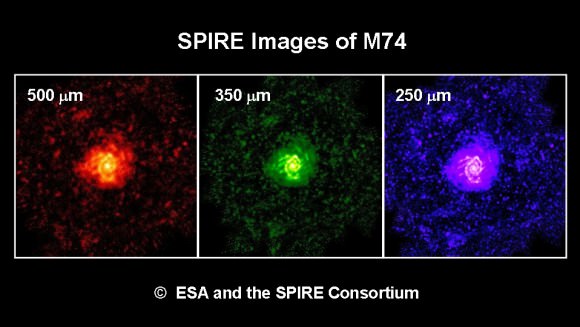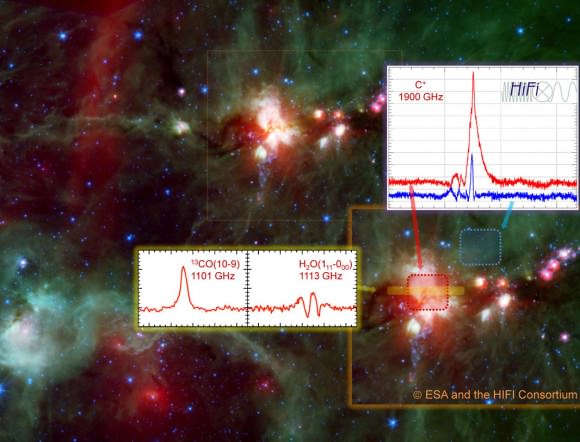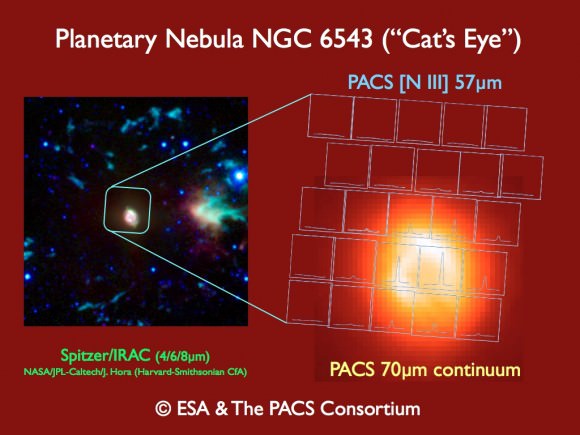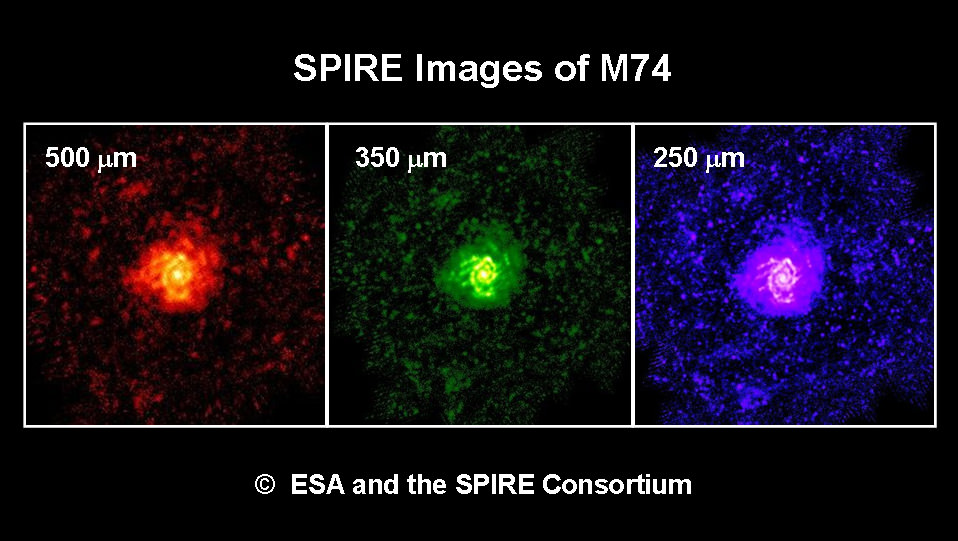[/caption]
The Herschel telescope has now turned on all its instruments, taking a few “first light” images with each instrument of galaxies, star-forming regions and dying stars. Herschel astronomers said they were “staggered” by the results, saying “these observations show that Herschel’s instruments are working beyond expectations. They promise a mission of rich discoveries for waiting astronomers.” Above are images taken with Herschel’s Spectral and Photometric Imaging Receiver (SPIRE, of two galaxies, M66 and M74. The galaxies showed up prominently, providing astronomers with their best images yet at these wavelengths. And what’s that in the background? Other more distant galaxies!

Here are three images of M74 taken in three different wavelengths, and of special note is the image taken at 250 microns. This is longer than any previous infrared space observatory. Herschel’s primary mirror is 3.5 m in diameter, nearly four times larger than any previous infrared space telescope. So, expect more dazzling imagery and science to come.
Water in Cygnus

Scientists used Herschel’s Heterodyne Instrument for the Far-Infrared (HIFI) to look for warm molecular gas heated by newborn massive stars in the DR21 star-forming region in Cygnus. They were able to observe ionized carbon, carbon monoxide, and water in this region.
HIFI provided excellent data in two different observing modes, returning information on the composition of the region with unprecedented accuracy and resolution. It works by ‘zooming in’ on specific wavelengths, revealing different spectral ‘lines’ that represent the fingerprints of atoms and molecules and even the physical conditions of the object observed. This makes it a powerful tool to study the role of gas and dust in the formation of stars and planets and the evolution of galaxies.
PACS stares into the Cat’s Eye

The first observation with the Photodetector Array Camera and Spectrometer (PACS) instrument shows the Cat’s Eye Nebula; a complex shell of gas thrown off by a dying star. Dying stars create spectacular nebulae, enriching the interstellar medium with heavy chemical elements. But how does an initially spherical star produce such a complex nebula? Further observations with PACS should help answer questions like that. This instrument makes it possible, for the first time, to take images in spectral lines and see how the wind from the star shapes the nebula in three dimensions.
PACS observed the nebula in two spectral lines from ionized nitrogen and oxygen. It also obtained a small map of the Cat’s Eye Nebula in the 70 micron band, revealing the structure of a dust ring with an opening on one side.
The Herschel instruments will now be tested and calibrated, and the official mission should start around the end of November. “These images demonstrate that there is a lot of science to look forward to,” the scientists said.
Sources: ESA, Herschel Twitter


I like the second image. Nice demo of resolution as a function of wavelength.
Great to see these ‘first light’ images from Herschel. Can’t wait to see imaging and spectra of A1689 zD1, SSA 22, and spectra of exoplanet atmospheres 🙂
Some people out there who are not familiar with wavelengths may be looking at these images, and thinking they have seen better, sharper infra-red images.
Yep – you probably have seen sharper images. The ‘cat’s eye’ is usually a proper eye, and not a smudge. But you haven’t seen them at these wavelengths.
The wavelengths we normally see are measured in nanometers – 400 nm is blue, and 700 nm is a deep red. Night vision goggles, which usually use an IR lamp use wavelengths from 1-3 ? (microns). Thermal imaging cameras which will image you by your body heat use the region from 8-14 ?. SPIRE is not looking at your regular infra-red but way down at the terahertz band, where the energies are fifty times smaller than your regular thermal imaging, and you can catch the rotations of particular chemicals in cold gas clouds.
This is going to be good.
Yes, this should provide for increased detail of observation & measurement.
That’s a good thing.
And, with consideration of all the possibilities, allow for an increased understanding of the physical processes involved in various astrophysical objects.
Now is the time to be increasingly open to alternative possibilities and the investigation of those possibilities, rather than to exercise a self-limiting set of assumptions before the detailed observations & measurements are carried out.
Take note of the SPIRE images of M74: Notice the filaments that are seperate from the “arms” of the galaxy.
A possible avenue of investigation could be asking, what are those filaments and how are they generated?
Increased observation & measurement power should allow for more questions to be asked, not fewer, and hopefully as analysis & interpretation progress, and be answered.
Tim Thompson’s statement:
“Wrong. I believe no such thing and neither does anyone else I know. Electric currents certainly do play a vital role in events in space, on every spatial scale from the smallest to the largest. They are incorporated into standard physical models of the solar system and cosmology. There are whole books and reams of papers on the topic. Electric currents do play a vital role in events in space without question.”
And further: “However, you and the EU folks make the wrong assumption that electric currents always dominate in all cases and all spatial scales, over every other force, always. You fail to realize the interplay between force in physics. Sometimes plasma & electric currents dominate, sometimes not. Sometimes it’s not easy to tell which dominates.”
“Sometimes plasma & electric currents dominate, sometimes not. Sometimes it’s not easy to tell which dominates.”
So, let’s find out shall we?
Sure why not?
Would you like some recommendations for universities which have good astronomy programmes, Anaconda? Or perhaps some advice on what you can expect when you start your studies?
(bold added)
Although I expect it will be many years before you write your first paper, even if only as a co-author, I look forward to reading what you find.
It’s Nereid…hit the snooze button…
The net coloumb field surrounding 2 opposite charged particles is … zero. Exactly zero, Atleast in classical electromagnetism.
If you displace the 2 charged particles a distance d, the local forcefield will become scewed. On one side there is an approximate +d/r^3 and in the opposite direction it will be approximately -d/r^3, and taken over the whole volume of space – the field is – net zero. It is just locally taking on values different from zero.
Now take something like a huge plasma cloud, like the Sun. Something like 10^58 charged particles. Not all may be separated ofc, but for sake of argument lets assume all are and that it is only hydrogen.
If they were all to align, the resulting coloumb force can behave as +1/r^3 on one side, and -1/r^3 on the opposite side. But the chance of 10^58 particles to align in such a way is rediculously small. The chargeseparation in this case would become something of a gaussian distribution over time with the median at zero, and an uncertainty proprtional to 1/sqrt(10^58) = 10^-29. So even though electromagetic forces are 10^36 times large than gravity, on the larger picture it will be very much cancelled out by several effects. The more matter you add, the worse it becomes on eletromagnetism.
But even so, the net coloumb force over the entire volume of space will be zero – exactly zero with the known relations. It will just locally be different than zero.
So in terms of the universe – electromagnetism is a very weak force compared to gravtiy – it is closing in on zero.
So much for coloumb force, magnetic forces are not due to placement of charges but due to movement of them. And the average movement of all charges combined is – zero – only locally will there be a net movement of charges, and hence a net magnetic field – on a grander scale this movement will average out. Unless ofcourse the whole of the universe is somehow moving.
So classical electrodynamitcs results in net zero forces.
Classical gravty do not result in a net zero force.
What a relativistic analysis would say might add to that, and one thing is certain and that is that this is not the end of it, but electromagnetism scales extremely poorly on the grand…
So now i have tried some to find out an answer, and although not conclusive it does point away from eletromagnetsim. Is my analysis incorrect ?
@Excalibur: yes, your analysis is more or less correct.
There are, of course, quite a few caveats to enter, and some of them are quite interesting.
For example, speaking very loosely, local magnetic fields can have far-from-local impacts … the energy density (per volume) of (galactic) cosmic rays (CRs) is considerable (comparable to that of starlight, IIRC), and it is via local magnetic fields that CRs are accelerated, and via other local magnetic fields that their overall direction distribution becomes isotropic.